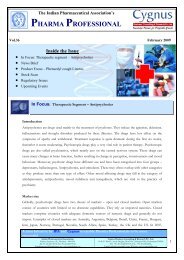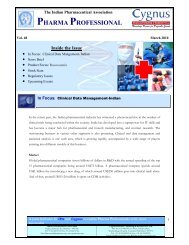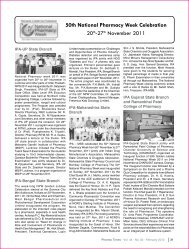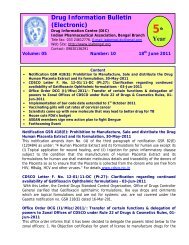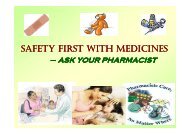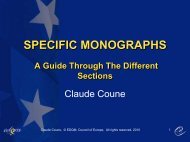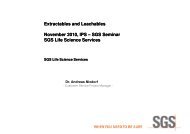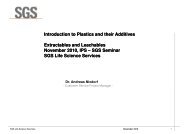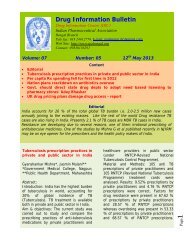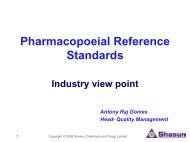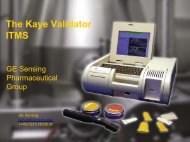Regulatory Stratergies for Biosimilars in Regulated and Emerging ...
Regulatory Stratergies for Biosimilars in Regulated and Emerging ...
Regulatory Stratergies for Biosimilars in Regulated and Emerging ...
You also want an ePaper? Increase the reach of your titles
YUMPU automatically turns print PDFs into web optimized ePapers that Google loves.
Article<br />
<strong>Regulatory</strong> <strong>Stratergies</strong> <strong>for</strong> <strong>Biosimilars</strong> <strong>in</strong><br />
<strong>Regulated</strong> <strong>and</strong> Emerg<strong>in</strong>g Markets<br />
Soundarya Reddy, Balamuralidhara V*, Pramod Kumar T.M., Teja C.H. <strong>and</strong> Shreekanth Reddy<br />
Pharmaceutical <strong>Regulatory</strong> Affairs Group, Dept. of Pharmaceutics, JSS College of Pharmacy, JSS University,<br />
Mysore.<br />
The objective of this article is to facilitate regulatory requirements <strong>for</strong> the approval process of <strong>Biosimilars</strong><br />
<strong>and</strong> the need <strong>for</strong> Biosimilar product class-specific guidel<strong>in</strong>es <strong>in</strong> <strong>Regulated</strong> (EU, US, JAPAN) <strong>and</strong> emerg<strong>in</strong>g<br />
markets (KOREA, CHINA, INDIA). <strong>Biosimilars</strong> are biological products that are the replicas of their <strong>in</strong>novator<br />
biopharmaceuticals. Specified regulations, <strong>and</strong> approval process of generic version of biologicals exists<br />
depend<strong>in</strong>g on the country. Each class of biologic varies <strong>in</strong> its benefit / risk profile, the nature <strong>and</strong> frequency of<br />
adverse events, the breadth of cl<strong>in</strong>ical <strong>in</strong>dications, <strong>and</strong> whether surrogate markers <strong>for</strong> efficacy are available <strong>and</strong><br />
validated. But most of the countries do not have specific guidel<strong>in</strong>es <strong>for</strong> potential market biological products like<br />
monoclonal antibodies (mAbs), <strong>in</strong>terferon beta, <strong>and</strong> <strong>in</strong>sul<strong>in</strong>. European Medic<strong>in</strong>es Agency (EMA) has developed<br />
product class-specific guidel<strong>in</strong>es to biosimilars that def<strong>in</strong>e the nature of comparative studies.<br />
The biggest challenges fac<strong>in</strong>g biosimilar drug developers is<br />
Introduction<br />
2011 (1) Avast<strong>in</strong> 2018 bevacizumab Roche<br />
<strong>Biosimilars</strong> or follow-on biologics are terms used<br />
to describe officially-approved subsequent versions of<br />
<strong>in</strong>novator biopharmaceutical products made by a different sponsor<br />
follow<strong>in</strong>g patent <strong>and</strong> exclusivity expiry on the <strong>in</strong>novator product.<br />
The term Biosimilar is used by EMA (European Medic<strong>in</strong>es Agency)<br />
or versions of marketed therapeutics that, from a regulatory<br />
perspective, cannot be considered like simple generic drugs due<br />
to their structural complexity. <strong>Biosimilars</strong> are legally approved<br />
subsequent versions of <strong>in</strong>novator biopharmaceutical products<br />
follow<strong>in</strong>g patent <strong>and</strong> exclusivity expiry. However, the def<strong>in</strong>ition of<br />
prov<strong>in</strong>g the equivalence or similarity of their biological drug to the<br />
reference product because of great variation <strong>in</strong> properties <strong>and</strong> even<br />
small alterations can lead to unacceptable changes <strong>in</strong> safety <strong>and</strong><br />
efficacy. So there is a need of class-specific guidel<strong>in</strong>es <strong>for</strong> various<br />
complex molecules of biological. The EMA has developed product<br />
class-specific guidel<strong>in</strong>es <strong>for</strong> erythropoiet<strong>in</strong>’s, <strong>in</strong>sul<strong>in</strong>’s, growth<br />
hormones, Alfa <strong>in</strong>terferon, granulocyte-colony stimulat<strong>in</strong>g factors<br />
<strong>and</strong> low-molecular weight hepar<strong>in</strong>s (LMWH), with three more (beta<br />
<strong>in</strong>terferons, follicle stimulation hormone, monoclonal antibodies)<br />
currently be<strong>in</strong>g drafted .<br />
biosimilars differs among the various regulatory agencies across<br />
The Biosimilar market is expected to reach $3.6 billion by 2016,<br />
the world. Internationally, different names are used <strong>for</strong> Biosimilar;<br />
a compound annual growth rate (CAGR) of 7.7%. Monoclonal<br />
<strong>for</strong> example, they are known as similar biological medic<strong>in</strong>al products<br />
antibodies have been established as a major product class of<br />
by the EMA <strong>and</strong> KOREA Food & Drug Adm<strong>in</strong>istration (KFDA),<br />
biotechnology-derived medic<strong>in</strong>al products. Monoclonal antibodies<br />
as follow-on prote<strong>in</strong> products or follow-on biologics by the Food<br />
represent the largest sector of the biologics market <strong>and</strong> a significant<br />
<strong>and</strong> Drug Adm<strong>in</strong>istration (FDA) <strong>and</strong> M<strong>in</strong>istry of Health, Labor <strong>and</strong><br />
opportunity <strong>for</strong> biosimilar developers, driven by the ris<strong>in</strong>g <strong>in</strong>cidence<br />
Welfare (MHLW) as subsequent entry biologics by Health Canada.<br />
<strong>and</strong> prevalence of cancer <strong>and</strong> the therapeutic success of these<br />
Biological drugs constitute one of the largest grow<strong>in</strong>g sectors<br />
targeted therapies. Patents <strong>for</strong> top-sell<strong>in</strong>g monoclonal antibody<br />
of the pharmaceutical <strong>in</strong>dustry, with total global sales <strong>in</strong> 2011<br />
drugs are go<strong>in</strong>g to expire shortly.<br />
exceed<strong>in</strong>g $2.5 billion <strong>in</strong> 2011. Biosimilar products are different<br />
therapeutic classes, <strong>in</strong> this exist<strong>in</strong>g biosimilars are erythropoiet<strong>in</strong>’s,<br />
growth hormones, granulocyte-colony stimulat<strong>in</strong>g factors <strong>and</strong> lowmolecular<br />
Table 2: Patent Expir<strong>in</strong>g Drugs (2)<br />
weight hepar<strong>in</strong>s (LMWH) <strong>and</strong> emerg<strong>in</strong>g biosimilars are Br<strong>and</strong> name Year of INN COMPANY NAME<br />
Alfa <strong>in</strong>terferon’s, Beta <strong>in</strong>terferon’s, follicle stimulation hormone,<br />
<strong>in</strong>sul<strong>in</strong>’s, monoclonal antibodies.<br />
Remicade<br />
expir<strong>in</strong>g<br />
2014 Infliximab J&J<br />
Global Biosimilar Dem<strong>and</strong> by Value <strong>and</strong> Product Type, Humira 2016 adalimumab Abbott<br />
*Email Id: baligowda@gmail.com<br />
Mab/reditux 2015 Rituximab Roche/biogenidec<br />
Herecept<strong>in</strong> 2015 Trastuzumab Roche<br />
Enbrel 2012 Etanercept Amgen/Pfizer<br />
Orencia 2019 abatacept Bms<br />
Aranesep 2016 darbepoet<strong>in</strong>alfa Amgen<br />
Neulasta 2017 pegpelgrastrim Amgen<br />
Rituxan 2013 rituximab Genentec<br />
Pharma Times - Vol. 45 - No. 1 - January 2013 11
REGULATORY REQUIREMENTS:<br />
World Health Organisation (3) (WHO)<br />
As an <strong>in</strong>creas<strong>in</strong>gly wide range of SBPs are under development<br />
or are already licensed <strong>in</strong> many countries, WHO <strong>for</strong>mally recognized<br />
the need <strong>for</strong> the guidance <strong>for</strong> their evaluation <strong>and</strong> overall regulation<br />
<strong>in</strong> 2007. “Guidel<strong>in</strong>es on Evaluation of Similar Biotherapeutic<br />
Products (SBPs)” was developed <strong>and</strong> adopted by the 60 th meet<strong>in</strong>g<br />
of the WHO Expert Committee on Biological St<strong>and</strong>ardization <strong>in</strong><br />
2009. WHO Guidel<strong>in</strong>e issued April 2010.<br />
Scope (4) : Well-established <strong>and</strong> well-characterized biotherapeutic<br />
products such as recomb<strong>in</strong>ant DNA therapeutic prote<strong>in</strong>s, vacc<strong>in</strong>es<br />
<strong>and</strong> plasma derived products <strong>and</strong> their recomb<strong>in</strong>ant analogues are<br />
out of scope. Key pr<strong>in</strong>ciples <strong>for</strong> evaluation of SBPs are basis <strong>for</strong><br />
sett<strong>in</strong>g national requirements. In these guidel<strong>in</strong>es WHO covered<br />
the regulatory requirements <strong>for</strong> quality, safety <strong>and</strong> efficacy of SBPs<br />
quality as a prerequisite <strong>for</strong> the reduction of the non-cl<strong>in</strong>ical <strong>and</strong><br />
cl<strong>in</strong>ical data set requirement <strong>for</strong> licensure.<br />
The <strong>in</strong>tention of the guidel<strong>in</strong>es is to provide globally acceptable<br />
pr<strong>in</strong>ciples <strong>for</strong> licens<strong>in</strong>g biotherapeutic products that claim to be<br />
similar to that of the reference products which have been licensed<br />
based on a full sale licens<strong>in</strong>g dossier. The WHO has not issued<br />
product specific noncl<strong>in</strong>ical or cl<strong>in</strong>ical guidel<strong>in</strong>es.<br />
European Union (EU)<br />
<strong>Biosimilars</strong> were first <strong>in</strong>troduced <strong>in</strong> Europe today; the cont<strong>in</strong>ent<br />
has the largest biosimilars market <strong>in</strong> the world. In 2010, the<br />
European biosimilars market generated revenues of approximately<br />
$172 million. As on 31 st December, 2010 14 biosimilar drugs have<br />
been approved <strong>in</strong> Europe.<br />
Table 3: Approved <strong>Biosimilars</strong> <strong>in</strong> Europe (5)<br />
Biosimilar INN Company Approval<br />
year<br />
Omnitrope Somatrop<strong>in</strong> S<strong>and</strong>oz 2006<br />
Valtrop<strong>in</strong><br />
Biopartners<br />
B<strong>in</strong>ocrit Epoet<strong>in</strong> Alfa S<strong>and</strong>oz<br />
Epot<strong>in</strong> Alfa Hexal<br />
Hexal<br />
Abseamed<br />
Medice<br />
Silapo Epoet<strong>in</strong> Zeta Stada<br />
2007<br />
Retecrit<br />
Hospira<br />
FilgrastimRatiopharm<br />
Ratiograstim<br />
Ratiopharm<br />
Ratiopharm<br />
Biograstim<br />
CT Arzneimittel 2008<br />
Tevagrastim Filgrastim Teva<br />
FilgrastimHexal Hexal 2009<br />
Zarzio<br />
S<strong>and</strong>oz<br />
Nivestim Hospira 2010<br />
EU has an approached route of thought <strong>and</strong> which is also an<br />
evidence-based approach, established a well-documented legal <strong>and</strong><br />
regulatory pathway <strong>for</strong> the approval of biosimilar products which<br />
is dist<strong>in</strong>ct from the generic pathway. In order to grant a biosimilar<br />
product, the EMA requires comprehensive <strong>and</strong> justified comparability<br />
studies between the biosimilar <strong>and</strong> the reference products <strong>in</strong> the<br />
quality, noncl<strong>in</strong>ical, <strong>and</strong> cl<strong>in</strong>ical level, which are expla<strong>in</strong>ed <strong>in</strong> detail <strong>in</strong><br />
the EMA guidel<strong>in</strong>es (6) . The approval pathway of biosimilar products<br />
<strong>in</strong> the EU is based on case-by-case reviews, ow<strong>in</strong>g to the complexity<br />
<strong>and</strong> diversity of the biologic products. There<strong>for</strong>e, besides the three<br />
general guidel<strong>in</strong>es, EMA also developed additional product classspecific<br />
guidel<strong>in</strong>es on non-cl<strong>in</strong>ical <strong>and</strong> cl<strong>in</strong>ical studies.<br />
• Quality: “Guidel<strong>in</strong>e on similar biological medic<strong>in</strong>al products<br />
conta<strong>in</strong><strong>in</strong>g biotechnology-derived prote<strong>in</strong>s as active substance”:<br />
Quality issues” (EMEA/CHMP/BWP/49348/2005).<br />
• The “Guidel<strong>in</strong>e on development, production, characterisation <strong>and</strong><br />
specifications <strong>for</strong> monoclonal antibodies <strong>and</strong> related substances”<br />
(EMEA/CHMP/BWP/157653/2007).<br />
• Guidel<strong>in</strong>e on similar biological medic<strong>in</strong>al products conta<strong>in</strong><strong>in</strong>g<br />
biotechnology-derived prote<strong>in</strong>s as active substance: non-cl<strong>in</strong>ical,<br />
cl<strong>in</strong>ical issues <strong>in</strong> (EMEA/CPMP/42832/2005).<br />
Specific Guidel<strong>in</strong>es (7)<br />
Each class of biologic varies <strong>in</strong> its benefit / risk profile, the<br />
nature <strong>and</strong> frequency of adverse events, the breadth of cl<strong>in</strong>ical<br />
<strong>in</strong>dications, <strong>and</strong> whether surrogate markers <strong>for</strong> efficacy are available<br />
<strong>and</strong> validated. Accord<strong>in</strong>gly, the EMA has developed product classspecific<br />
guidel<strong>in</strong>es that def<strong>in</strong>e the nature of comparative studies. So<br />
far, guidance <strong>for</strong> the development of biosimilar products has been<br />
developed <strong>for</strong> six different product classes, <strong>in</strong>clud<strong>in</strong>g erythropoiet<strong>in</strong>s,<br />
<strong>in</strong>sul<strong>in</strong>s, growth hormones, Alfa <strong>in</strong>terferons, granulocyte-colony<br />
stimulat<strong>in</strong>g factors <strong>and</strong> low-molecular weight hepar<strong>in</strong>s (LMWH), with<br />
three more (beta <strong>in</strong>terferons, follicle stimulation hormone, monoclonal<br />
antibodies) currently be<strong>in</strong>g drafted (8) . This approval pathway is now held<br />
as one of the golden st<strong>and</strong>ards <strong>for</strong> authoriz<strong>in</strong>g biosimilar products.<br />
• 2011: The “overarch<strong>in</strong>g guidel<strong>in</strong>e”, the “quality issues” <strong>and</strong> the “noncl<strong>in</strong>ical<br />
<strong>and</strong> cl<strong>in</strong>ical issues” guidel<strong>in</strong>es plus the erythropoiet<strong>in</strong> <strong>and</strong><br />
<strong>in</strong>sul<strong>in</strong>-specific guidel<strong>in</strong>es are under revision. The first draft guidel<strong>in</strong>e<br />
<strong>for</strong> recomb<strong>in</strong>ant follicle stimulation hormone is released.<br />
• 2010: The long-awaited draft guidel<strong>in</strong>e <strong>for</strong> monoclonal antibodies<br />
is released <strong>for</strong> consultation.<br />
• 2008: The draft guidel<strong>in</strong>e <strong>for</strong> low-molecular-weight hepar<strong>in</strong>s is<br />
issued (adopted <strong>in</strong> 2009).<br />
• 2007: The draft guidel<strong>in</strong>e <strong>for</strong> <strong>in</strong>terferon beta is issued (adopted<br />
2009).<br />
• 2005: The EMEA releases the general guidel<strong>in</strong>e drafts <strong>for</strong> “quality<br />
issues” <strong>and</strong> “non-cl<strong>in</strong>ical <strong>and</strong> cl<strong>in</strong>ical issues” <strong>and</strong> a little later, it<br />
releases draft guidel<strong>in</strong>es <strong>for</strong> erythropoiet<strong>in</strong>, growth hormone, G-CSF<br />
<strong>and</strong> <strong>in</strong>sul<strong>in</strong>. All are adopted <strong>in</strong> 2006.<br />
United States of America (Usfda)<br />
The market (9) <strong>in</strong> the United States <strong>for</strong> Biosimilar reached $507<br />
million <strong>in</strong> 2010 <strong>and</strong> $1.1 billion <strong>in</strong> 2011. The market is expected<br />
to reach $1.3 billion by 2016, a CAGR of 4.1%. In US <strong>in</strong> the past,<br />
some of the biopharmaceuticals have got approved as 505(b)<br />
(2) generic drugs <strong>and</strong> entered the market. In March 2009, the<br />
“Promot<strong>in</strong>g Innovation <strong>and</strong> Access to life-sav<strong>in</strong>g Medic<strong>in</strong>es Act”<br />
as <strong>in</strong>troduced to the US Congress, authorized US Food <strong>and</strong> Drug<br />
Adm<strong>in</strong>istration (FDA) to approve follow-on biologics/biosimilars <strong>in</strong><br />
an abbreviated manner. The approval of abbreviated biosimilar /<br />
biologics license applications (bBLAs) or 351(k) fil<strong>in</strong>gs is based<br />
largely on the sponsors prov<strong>in</strong>g structural, composition <strong>and</strong><br />
cl<strong>in</strong>ical similarities with a reference product. The Biologics Price<br />
Competition <strong>and</strong> Innovation Act of 2009 (BPCI Act) was enacted<br />
as part of the Patient Protection <strong>and</strong> Af<strong>for</strong>dable Care Act on 23 rd<br />
March, 2010. The BPCI Act has created an abbreviated licensure<br />
pathway <strong>for</strong> biological products demonstrated to be biosimilar to,<br />
or <strong>in</strong>terchangeable with, a reference product.<br />
In the US, no products have been approved yet under a<br />
biosimilar pathway, but two have been approved under the 505(b)<br />
(2) regulatory pathway of the Federal Food, Drug, <strong>and</strong> Cosmetics<br />
Act Enoxapar<strong>in</strong> (Lovenox), a low-molecular hepar<strong>in</strong>; <strong>and</strong> Omnitrope<br />
(Genotrop<strong>in</strong>) , a generic of the growth hormone. S<strong>in</strong>ce March 2010,<br />
the US provisions <strong>for</strong> biosimilars have been def<strong>in</strong>ed via the Patient<br />
Protection <strong>and</strong> Af<strong>for</strong>dable Care Act (PPACA). They are set out <strong>in</strong><br />
PPACA (10) Sections 3139 <strong>and</strong> 7001 to 7003. The latter sections<br />
are the “Biologics Price Competition <strong>and</strong> Innovation Act of 2009”<br />
(BPCIA), which <strong>in</strong>serts Sections 351(k), 351(l), <strong>and</strong> 351(m) <strong>in</strong>to<br />
Pharma Times - Vol. 45 - No. 1 - January 2013 12
the Public Health Service Act (PHSA), <strong>in</strong>troduc<strong>in</strong>g the approval<br />
pathway <strong>for</strong> biosimilars.<br />
On 9 th February, 2012, the FDA published three draft<br />
guidance (11) documents on biosimilar product development<br />
Interchangeability of Biosimilar<br />
Another important issue raised by the BPCI Act is the<br />
<strong>in</strong>terchangeability of biosimilars. Once approved, st<strong>and</strong>ard<br />
generic drugs can be automatically substituted <strong>for</strong> the reference<br />
product without the <strong>in</strong>tervention of the healthcare provider <strong>in</strong><br />
many states. However, the automatic <strong>in</strong>terchangeability cannot be<br />
applied to all biosimilars. In order to meet the higher st<strong>and</strong>ard of<br />
<strong>in</strong>terchangeability, a sponsor must demonstrate that the biosimilar<br />
products can be expected to produce the same cl<strong>in</strong>ical result as<br />
the reference product <strong>in</strong> any given patient.<br />
Similar to the requirement of the WHO <strong>and</strong> EMA, a number<br />
of factors are considered important by the FDA when assess<strong>in</strong>g<br />
applications <strong>for</strong> biosimilars, <strong>in</strong>clud<strong>in</strong>g the robustness of the<br />
manufactur<strong>in</strong>g process, the demonstrated structural similarity,<br />
the extent to which mechanism of action was understood, the<br />
existence of valid, mechanistically related pharmacodynamic<br />
assays, comparative pharmacok<strong>in</strong>etics <strong>and</strong> immunogenicity <strong>and</strong><br />
the amount of cl<strong>in</strong>ical data <strong>and</strong> experience available with the<br />
orig<strong>in</strong>al products.<br />
JAPAN (MHLW)<br />
Japan’s Pharmaceuticals <strong>and</strong> Medical Devices Agency (PMDA)<br />
has had a biosimilar guidel<strong>in</strong>e (12) s<strong>in</strong>ce 2009 <strong>and</strong> has already<br />
authorized biosimilar products accord<strong>in</strong>g to it. It is very similar to the<br />
EU pathway <strong>in</strong> that they require a thorough comparability exercise<br />
to prove similarity to the reference product.<br />
• S<strong>and</strong>oz’s Omni trope ® <strong>and</strong> one epoet<strong>in</strong>-alfa product are the<br />
Biosimilar approved (13) <strong>in</strong> Japan.<br />
• Update specific products to Annex (ex: INFa, mab or others if<br />
review experiences accumulated).<br />
• “Guidel<strong>in</strong>es <strong>for</strong> the Quality, Safety <strong>and</strong> Efficacy Assurance of<br />
follow-on biologics” (Yakushokush<strong>in</strong>sahatu 0304007 by MHLW<br />
/ March 4, 2009)<br />
• “Non-proprietary name <strong>and</strong> br<strong>and</strong> name of follow-onbiologics”<br />
(Yakushokush<strong>in</strong>sahatu 0304011 by MHLW / March 4, 2009)<br />
• “Revision of market<strong>in</strong>g approval application”(Yakushokush<strong>in</strong>sa<br />
hatu 0331015 by MHLW / March 4, 2009)<br />
The expiry dat<strong>in</strong>g of biosimilar products should be determ<strong>in</strong>ed<br />
based on the data of real-time / real-temperature studies.<br />
However, there are some differences <strong>in</strong> the requirements of<br />
stability test <strong>and</strong> toxicology studies <strong>for</strong> impurities <strong>in</strong> biosimilars<br />
between EU <strong>and</strong> Japan. A comparison of the stability of a<br />
biosimilar with the reference <strong>in</strong>novator products as a strategy<br />
<strong>for</strong> development of biosimilar is not always necessary <strong>in</strong> Japan.<br />
Accelerated <strong>and</strong> stress stability studies are recommended to<br />
obta<strong>in</strong> useful data <strong>for</strong> evaluat<strong>in</strong>g the properties of the biosimilar<br />
product. In addition, it is not required to evaluate the safety of<br />
impurities <strong>in</strong> the biosimilar product through non-cl<strong>in</strong>ical studies<br />
without comparison to the orig<strong>in</strong>al product. Accord<strong>in</strong>g to this<br />
guidel<strong>in</strong>e, two follow-on biologics, “Somatrop<strong>in</strong>” <strong>and</strong> “Epoet<strong>in</strong>alfa<br />
BS” have been recently approved <strong>in</strong> Japan.<br />
KOREA (KFDA)<br />
South Korea has had a regulatory pathway <strong>in</strong> place <strong>for</strong><br />
biosimilars s<strong>in</strong>ce 2009, when electronics giant Samsung announced<br />
its entry to the biosimilar arena with an <strong>in</strong>vestment of $389 million<br />
over the next five years.<br />
In Korea, “Pharmaceutical Affairs Act” is the high level regulation<br />
to license all medic<strong>in</strong>es <strong>in</strong>clud<strong>in</strong>g biologic products. The Korea Food<br />
<strong>and</strong> Drug Adm<strong>in</strong>istration (KFDA) notifications serve as a lower<br />
level regulation. Biological products <strong>and</strong> biosimilars are subject to<br />
that of “Notification of the regulation on review <strong>and</strong> authorization<br />
of biological products”. The regulatory framework of biosimilar<br />
products <strong>in</strong> Korea is a three-tiered system: Pharmaceutical Affairs<br />
Act; Notification of the regulation on review <strong>and</strong> authorization<br />
of biological products; Guidel<strong>in</strong>e on evaluation of biosimilar<br />
products.<br />
As Korean guidel<strong>in</strong>e (14) <strong>for</strong> biosimilar products was developed<br />
along with that of the WHO’s, most of the requirements are similar<br />
except <strong>for</strong> that of the cl<strong>in</strong>ical evaluation to demonstrate similarity.<br />
The KFDA requires that equivalent rather than non-<strong>in</strong>ferior efficacy<br />
should be shown <strong>in</strong> order to open the possibility of extrapolation<br />
of efficacy data to other <strong>in</strong>dications of the reference product.<br />
Equivalence marg<strong>in</strong>s need to be pre-def<strong>in</strong>ed <strong>and</strong> justified, <strong>and</strong><br />
should be established with<strong>in</strong> the range which is judged not to be<br />
cl<strong>in</strong>ically different from reference products <strong>in</strong> cl<strong>in</strong>ical regards.<br />
Bio-Pharmaceutical companies actively engaged <strong>in</strong><br />
Biosimilar by country, 2011-2012 (15)<br />
CHINA (SFDA)<br />
State Food <strong>and</strong> Drug Adm<strong>in</strong>istration (SFDA) <strong>in</strong> Ch<strong>in</strong>a had<br />
approved 40 biopharmaceutical products up until December 2011<br />
the majority of which were <strong>Biosimilars</strong>. Guidance <strong>for</strong> Review <strong>and</strong><br />
Approval of Biosimilar Products guidel<strong>in</strong>es (16) was announced<br />
by DOH <strong>in</strong> 2008, <strong>and</strong> is ma<strong>in</strong>ly based on EMA guidel<strong>in</strong>es with<br />
consideration of local regulatory environment. And it is follow<strong>in</strong>g<br />
centralized procedure <strong>for</strong> approval.<br />
• Guidel<strong>in</strong>es <strong>for</strong> Registration of Drugs (2010)<br />
• Guidance <strong>for</strong> Review <strong>and</strong> Approval of Recomb<strong>in</strong>ant Prote<strong>in</strong><br />
Drugs (2002)<br />
• Guidance <strong>for</strong> Review <strong>and</strong> Approval of Biosimilar Product<br />
(2008)<br />
• Po<strong>in</strong>ts to Consider <strong>for</strong> Common Technical Documents (CTD) <strong>in</strong><br />
Review <strong>and</strong> Approval of Biosimilar Product (2010)<br />
Interchange-ability of Biosimilar (17)<br />
Currently, no cl<strong>in</strong>ical studies have been undertaken to access<br />
cl<strong>in</strong>ical outcomes on repeated switches of a Biosimilar product<br />
<strong>and</strong> a reference product. Interchangeable cl<strong>in</strong>ical trials have to be<br />
executed <strong>and</strong> demonstrated, the same cl<strong>in</strong>ical result <strong>in</strong> any given<br />
patients, the risk <strong>in</strong> terms of safety is no more than that of us<strong>in</strong>g<br />
the reference product without a switch.<br />
INDIA (CDSCO)<br />
In India, apart from Central Drugs St<strong>and</strong>ard Control Organization<br />
(CDSCO), the office of Drug Controller General of India (DCGI) the<br />
apex regulatory body under Government of India (GoI), two other<br />
competent authorities are <strong>in</strong>volved <strong>in</strong> the approval process of<br />
Pharma Times - Vol. 45 - No. 1 - January 2013 13
iosimilars or Similar Biologics products (SBPs). These <strong>in</strong>clude:<br />
Review Committee on Genetic Manipulation (RCGM), which works<br />
under Department of Biotechnology (DBT), M<strong>in</strong>istry of Science <strong>and</strong><br />
Technology. RCGM regulates import, export, carry<strong>in</strong>g out research,<br />
precl<strong>in</strong>ical permission, No objection certificate <strong>for</strong> cl<strong>in</strong>ical trial (CT)<br />
<strong>and</strong> other related activities <strong>in</strong>volv<strong>in</strong>g genetically modified organism<br />
(GMO), as per the DBT guidel<strong>in</strong>es. Genetic Eng<strong>in</strong>eer<strong>in</strong>g Approval<br />
Committee (GEAC), which functions under the Department of<br />
Environment (DoE) as a statutory body <strong>for</strong> review <strong>and</strong> approval<br />
of activities <strong>in</strong>volv<strong>in</strong>g large scale use of genetically eng<strong>in</strong>eered<br />
organisms (Liv<strong>in</strong>g Modified Organism - LMO) <strong>and</strong> their products <strong>in</strong><br />
research <strong>and</strong> development, <strong>in</strong>dustrial production, environmental<br />
release <strong>and</strong> field applications.<br />
As far as the products are concerned, various biosimilar<br />
products be<strong>in</strong>g marketed currently <strong>in</strong>clude Erythropoiet<strong>in</strong>, Human<br />
Growth Hormone, Recomb<strong>in</strong>ant Human Insul<strong>in</strong>, G-CSF, <strong>and</strong><br />
Interferon. Industry statistics <strong>in</strong>dicate that <strong>in</strong> 2010, Epoet<strong>in</strong>alfa<br />
(Erythropoiet<strong>in</strong> Biosimilar) occupied more than 40% of the market<br />
share, followed by Filgrastim (G-CSF Biosimilar) with 33% market<br />
share, <strong>and</strong> Somatrop<strong>in</strong> (Human Growth Hormone Biosimilar) with<br />
25% market share.<br />
Table 4: Market overview of India (15)<br />
The Indian Biosimilar <strong>in</strong>dustry is estimated to be a US$<br />
338 million <strong>in</strong>dustry that has been grow<strong>in</strong>g at a compounded<br />
Annual Growth Rate (CAFR) of 30% s<strong>in</strong>ce 2008. This growth<br />
rate is expected to cont<strong>in</strong>ue till 2012. There are around 25 Indian<br />
companies operat<strong>in</strong>g <strong>in</strong> the Biosimilar space, market<strong>in</strong>g close to 50<br />
products <strong>in</strong> the Indian market <strong>and</strong> few of these products <strong>in</strong> some<br />
of the unregulated markets. India had approved approximately 50<br />
Biosimilar products up until December 2011.<br />
Ef<strong>for</strong>ts towards Harmonization<br />
Though the International Conference on Harmonisation of<br />
Technical Requirements <strong>for</strong> Registration of Pharmaceuticals <strong>for</strong><br />
Human Use (ICH) has not yet <strong>for</strong>mulated any guidel<strong>in</strong>es specific to<br />
biosimilars, some of its guidel<strong>in</strong>es (Q5) on biotechnology products<br />
are relevant to this area.<br />
Fundamental basic <strong>in</strong><strong>for</strong>mation we would have to submit <strong>for</strong><br />
biosimilars are the follow<strong>in</strong>g:<br />
• In<strong>for</strong>mation of authenticity of the active substance <strong>and</strong> medic<strong>in</strong>al<br />
drug (biosimilar) production process <strong>in</strong> comparison with the<br />
production processes of the active substance <strong>and</strong> reference<br />
biological medic<strong>in</strong>al product.<br />
• Proofs of structural similarity with the biological medic<strong>in</strong>al product<br />
<strong>and</strong> composition identity.<br />
• Reports on pre-cl<strong>in</strong>ical (non-cl<strong>in</strong>ical) comparative studies aimed<br />
at detection of differences <strong>in</strong> pharmacotoxicological properties<br />
of the biosimilar <strong>and</strong> reference biological medic<strong>in</strong>al product.<br />
• Reports on cl<strong>in</strong>ical studies conta<strong>in</strong><strong>in</strong>g the established equivalent<br />
quality <strong>and</strong> safety, safety <strong>and</strong> immunogenicity <strong>in</strong><strong>for</strong>mation<br />
presented on the basis of the study of a certa<strong>in</strong> number of<br />
patients sufficient <strong>for</strong> determ<strong>in</strong>ation of the biosimilar adverse<br />
reactions nature, <strong>and</strong> comparison of the nature, frequency <strong>and</strong><br />
severity of adverse reactions of the biosimilar with reference<br />
biological medic<strong>in</strong>al product.<br />
• Instructions on medical application with specification that the<br />
medical product is a biosimilar.<br />
• The cl<strong>in</strong>ical safety of biosimilar products should be followed <strong>and</strong><br />
monitored on an on-go<strong>in</strong>g basis dur<strong>in</strong>g post-market<strong>in</strong>g surveillance.<br />
Although there are still differences, the authorities are <strong>in</strong> contact<br />
to further harmonize them.<br />
Conclusion<br />
Biopharmaceuticals are different from small molecule chemical<br />
drugs. Generic drug approval approach is not appropriate.<br />
Establish<strong>in</strong>g a high degree of similarity <strong>in</strong> quality between the<br />
biosimilar product <strong>and</strong> the orig<strong>in</strong>al product is a crucial key <strong>in</strong> the<br />
regulatory approval process, because biologicals vary greatly <strong>in</strong><br />
properties <strong>and</strong> where even small alterations can lead to unacceptable<br />
changes <strong>in</strong> safety <strong>and</strong> efficacy. The efficacy <strong>and</strong> safety of biosimilars<br />
are <strong>in</strong> most cases highly species specific, which makes per<strong>for</strong>m<strong>in</strong>g<br />
noncl<strong>in</strong>ical studies more difficult <strong>and</strong> potentially expensive. So, there<br />
is a need <strong>for</strong> class-specific guidel<strong>in</strong>es <strong>for</strong> various complex molecules<br />
(erythropoiet<strong>in</strong>’s, <strong>in</strong>sul<strong>in</strong>’s, Alfa <strong>in</strong>terferons, <strong>and</strong> monoclonal<br />
antibodies etc.) of biologicals. Even though WHO have not issued<br />
product specific noncl<strong>in</strong>ical or cl<strong>in</strong>ical guidel<strong>in</strong>es, majority of ROW<br />
countries are follow<strong>in</strong>g these guidel<strong>in</strong>es. The EMA has developed<br />
product class-specific guidel<strong>in</strong>es <strong>for</strong> various therapeutic classes of<br />
biologicals. So, by consider<strong>in</strong>g EU, regulated <strong>and</strong> regulat<strong>in</strong>g market<br />
country regulatory authorities come <strong>for</strong>ward to draft product specific<br />
guidel<strong>in</strong>es <strong>for</strong> biosimilars to overcome these problems.<br />
REFERENCE<br />
1. http://www.bccresearch.com/pressroom/report/code/BIO090A/<br />
Global Markets<br />
2. http://www.gabionl<strong>in</strong>e.net/<strong>Biosimilars</strong>/Research/US-54-billion-worthof-biosimilar-patents-expir<strong>in</strong>g-be<strong>for</strong>e-2020<br />
3. http://www.gabionl<strong>in</strong>e.net/Reports/WHO-guidel<strong>in</strong>es-on-biosimilarscase-studies-<strong>and</strong>-discussion-highlights<br />
4. http://www.who.<strong>in</strong>t/medic<strong>in</strong>es/areas/quality_safety/regulation_<br />
legislation/icdra/PL5-2.pdf<br />
5. http://www.gabionl<strong>in</strong>e.net/<strong>Biosimilars</strong>/General/<strong>Biosimilars</strong>-approved<strong>in</strong>-Europe<br />
6. http://www.ema.europa.eu/ema/<strong>in</strong>dex.jsp?curl=pages/regulation/<br />
general/general_content_000408.jsp&mid=WC0b01ac058002958c<br />
7. http://www.gabionl<strong>in</strong>e.net/Reports/<strong>Biosimilars</strong>-marketed-<strong>in</strong>-Europe<br />
8. http://www.emea.europa.eu/docs/en_GB/document_library/<br />
Scientific_guidel<strong>in</strong>e/2009/09/WC500003517.pd<br />
9. https://www.pharmatch<strong>in</strong>g.com/<strong>in</strong><strong>for</strong>ena/pharma-outsourc<strong>in</strong>gpractice-biosimilars-guidel<strong>in</strong>es-players<br />
10. http://www.google.co.<strong>in</strong>/#hl=en&spell=1&q=Recent+Regulations+of<br />
+<strong>Biosimilars</strong>+<strong>in</strong>+Japan&sa=X&ei=o3NULe5FsztrQe_yoGQDQ&ved<br />
=0CBwQvwUoAA&bav=on.2,or.r_gc.r_pw.r_qf.&fp<br />
11. http://www.fda.gov/Drugs/DevelopmentApprovalProcess/<br />
HowDrugsareDeveloped<strong>and</strong>Approved/ApprovalApplications/<br />
TherapeuticBiologicApplications/<strong>Biosimilars</strong>/default.htm<br />
12. http://www.pmda.go.jp/regulatory/file/english_presentation/biologics/<br />
B-E1arato.pdf<br />
13. http://www.novartis.com/downloads/<strong>in</strong>vestors/shareholders<strong>in</strong><strong>for</strong>mation/Investor-Insights-2.pdf<br />
14. http://www.biosimilars.ca/docs/Evalutation_Guidel<strong>in</strong>es_<strong>for</strong>_<br />
<strong>Biosimilars</strong>.pdf<br />
15. http://www.expresspharmaonl<strong>in</strong>e.com/20120215/market04.shtml<br />
16. http://www.apecahc.org/images/tra<strong>in</strong><strong>in</strong>g/20120412/<br />
[Presentation]%2012_Yi%20Chu%20L<strong>in</strong>.pdf<br />
17. http://www.ibef.org/download/<strong>Biosimilars</strong>-<strong>in</strong>-India-30312.pdf<br />
18. http://www.ema.europa.eu/docs/en_GB/document_library/<br />
Presentation/2011/06/WC500107831.pdf<br />
Pharma Times - Vol. 45 - No. 1 - January 2013 14



